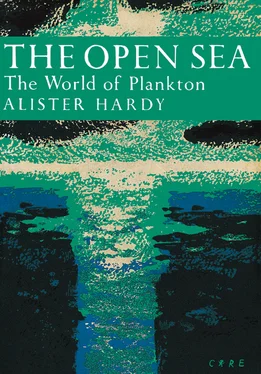2 Subjecting to a force greater than gravity by spinning in a rotary apparatus: the centrifuge.
CHAPTER 4SEASONS IN THE SEA

THE NATURALIST with a tow-net, if he can sample the plankton at different times of the year, will find contrasts between spring, summer, autumn and winter in our seas almost as striking as those in the vegetation on the land. These seasonal changes in the plankton have a profound effect on the lives of many fish. Just as we can tell the age of a felled tree by the number of concentric rings in its trunk representing summer and winter growth-zones, so we can tell the age of a herring by similar rings on its scales; these mark summer growth-periods, when its planktonic food was abundant, separated by lines showing where the scale, and the fish, had ceased to grow during winter when the plankton was scarce.
There is not, however, a simple and gradual increase in the plankton as spring advances into summer followed by a gradual decline in the autumn. Our naturalist with a tow-net will find some of the changes very puzzling at first sight. In British waters in the winter there is a general paucity of both animals and plants in the plankton; then as the sunlight grows stronger (the date varying in different years, but usually in March) there is a sudden outburst of plant activity. The little diatoms start dividing at a prodigious rate: in a week they may have multiplied a hundred-fold and by a fortnight perhaps ten-thousand-fold. The meshes of the tow-net are clogged by them and the little jar at its end is filled with a brown-green slime, a slime which under the microscope resolves itself into a myriad forms of beautiful design. Then as spring advances into summer the number of little floating plants steadily declines until by late summer there are surprisingly few. Some reduction in their numbers might indeed be expected, for the little animals in the plankton which feed on them are also multiplying as the season advances and the waters are warming up; with the increasing sunlight, however, we might have thought that the plants’ remarkable power of increase could largely keep pace with the grazing of the animals. Something seems to be preventing the diatoms from keeping up that rapid multiplication. In the autumn comes another surprise. As the days begin to shorten and the sunlight is getting less intense, when in fact we might least expect a renewal of plant activity, there comes a second phytoplankton outburst; it is not as spectacular as the spring maximum and not in every year is it of an equal intensity, but there it is—a definite surging up again of reproductive power. From this second peak of production, as winter approaches, the numbers fall again to the lowest level of the year.
This sequence of events was known for a long time before it was properly understood; it was only after much more had been discovered about the physics and chemistry of the sea that it was possible to see at all clearly the chain of cause and effect throughout the year. So important are these events that we must devote a little space to considering some of the more important elements in the physical and chemical background that will help us to explain them.
Let us first consider some of the physical properties of the water. At the very beginning, in the introductory chapter, we referred to the limited transparency of the sea and some figures were given to show how quickly light is actually absorbed on its passage below the surface. As might be expected absorption of light will be found to vary considerably according to the amount of suspended matter, either sediment or plankton, in the water. Far out from the land the water is usually much clearer than in the shallower regions against the coast where detritus and mud may continually be stirred up by the tides or brought in by drainage from the land. If we compare measurements of light made at different depths below the surface in the waters near Plymouth we find the penetration in inshore waters at Cawsand Bay to be only half what it is at a point some 10 miles S.W. of the Eddystone Lighthouse (Poole and Atkins, 1926). Taking the light entering the sea, i.e. just below the surface, as our standard, we find in Cawsand Bay that half of it has been absorbed at 2 metres depth (i.e. 1 fathom), some 75% at 4½ metres and 90% at about 8 metres depth; whereas at 10 miles out the same percentage reductions in light intensity are found at depths of about 4¼, 9½ and 17 metres respectively. At points in the open sub-tropical or tropical Atlantic, where the phytoplankton is very sparse, as in the Sargasso Sea, the corresponding depths might be increased four or five times. A very simple bit of apparatus known as the Secchi disc, which can easily be home-made, will enable you to compare the transparency of the sea at different points; you may well be surprised at some of the results you will get with it. Take a white painted metal disc, say two feet in diameter, and drill three equidistant holes near its margin; now take three cords each about 6 feet long, tie them to a weight, say a 7–1b lead, and then tie a knot in each at 3 feet from the lead; next pass the cords through the holes in the disc and bring them together as supporting bridles to be tied to a loop or eye at the end of the line which will suspend the whole device in the water as shown in Fig. 16. If a metal disc cannot easily be obtained, a white dinner plate, with wire clips behind it to take the cords will serve the purpose quite well. To compare the transparency of the sea all you have to do is to stop your boat and lower the disc over the side at different places and find how deep it must go before you can no longer see it. The weight not only carries the disc down but, if the cords are properly adjusted, ensures that it is always kept horizontal. The line can be knotted at metre intervals to facilitate measuring the depth. It is well to raise and lower it about the disappearance point several times in order to make quite sure just at what depth it goes out of sight; at some places it may vanish in only 5 metres, at others it may be seen for as much as 12 metres or more.
FIG. 16
The Secchi disc for measuring the transparency of the sea.
In passing I may say that the Secchi disc is also valuable in helping us to compare the varying colour of the water. Here, of course, I am not thinking of the often striking and delightful changes of hue which we may see as light of different quality is reflected from a changing sky: when for example dark grey clouds give place to an open space of blue or when cumulus clouds dapple the sea with purple shadows. Reference was made in Chapter 2to the contrast between the green water of the Channel and the deep blue of the Atlantic; such differences are due to the nature of the contents of the sea itself and are examples of what I mean by the varying colour of the water. A great variety of shades and hues may be found at different times; these are mainly due to the presence of different kinds of very small plankton organisms in exceptional numbers. The light reflected back through the water from the white background of the disc enables us to judge and compare these differences more easily than by just looking into the depths. Dense concentrations of diatoms such as Rhizosolenia and Biddulphia , or of the colonial flagellate Phaeocystis , may give a brown appearance to the water over large areas; the North Sea fishermen often call such patches of water “Dutchman’s baccy juice”. Some dinoflagellates may make the water almost red, coccolithophores may give it the white milky appearance referred to in the last chapter, and other small flagellates may occasionally make it a vivid green.
Читать дальше













